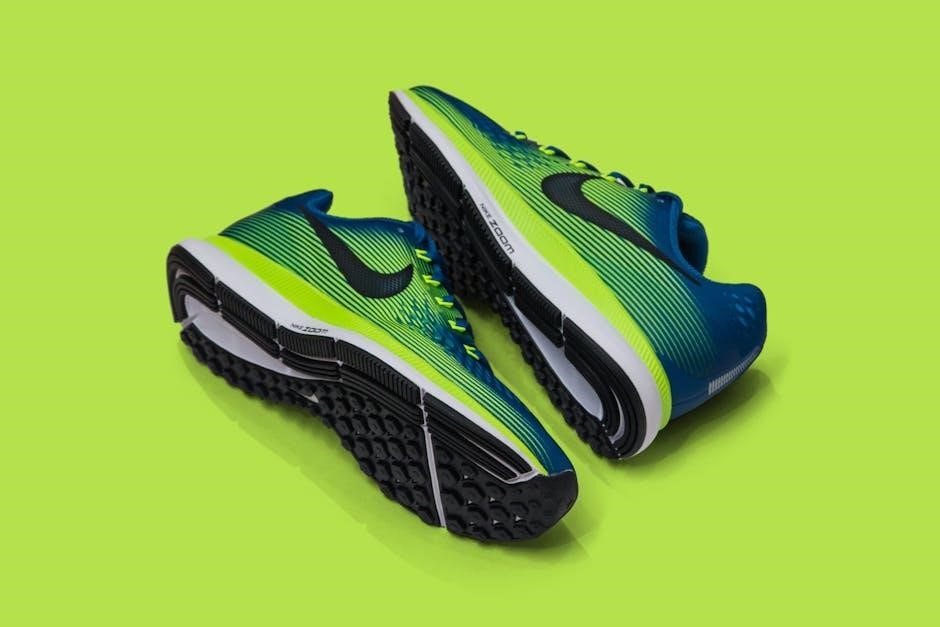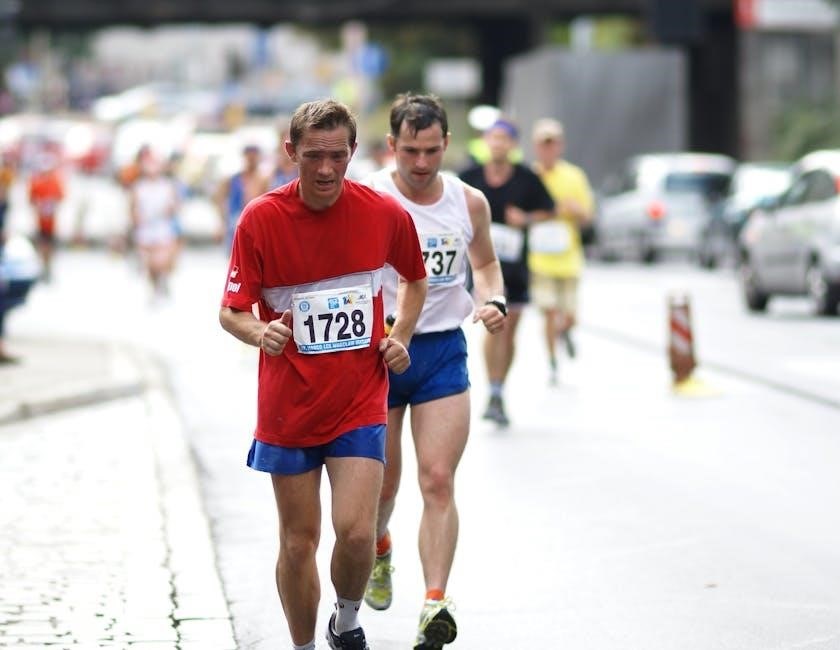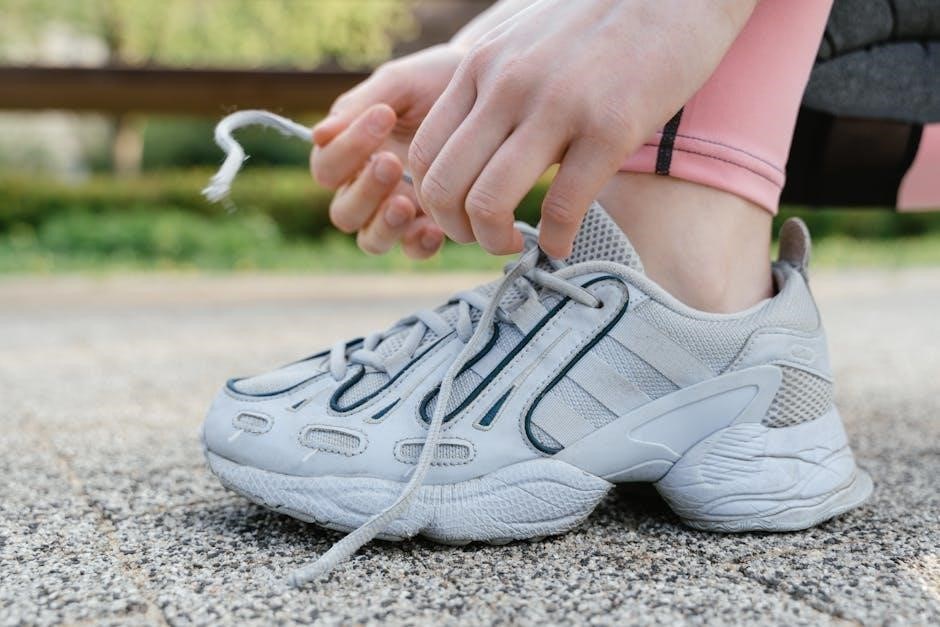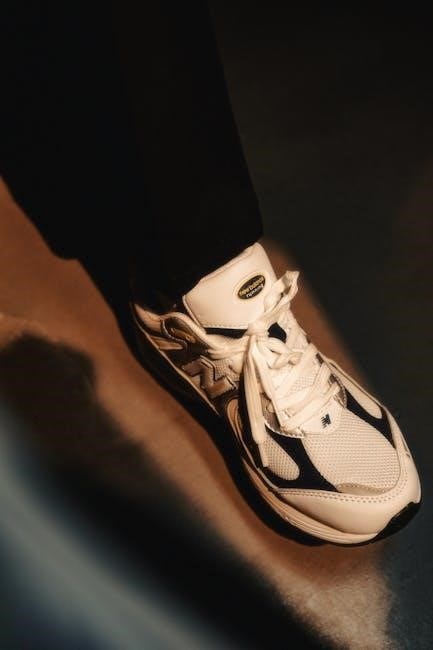Welcome to the Running Shoe Fit Guide, your ultimate resource for finding the perfect footwear. This guide covers proper fit, comfort, and performance, ensuring your shoes support your foot health and running goals. Learn how to choose the right pair with key considerations for toe room, midfoot snugness, and heel stability. Follow along for a seamless journey to your best fit.
1.1 Importance of Proper Fit in Running Shoes
A proper fit in running shoes is crucial for comfort, performance, and injury prevention. Ill-fitting shoes can lead to discomfort, blisters, and even long-term foot or ankle issues. A well-fitting shoe provides the necessary support and cushioning, allowing you to run efficiently and maintain proper foot mechanics. Whether you’re a casual jogger or a competitive athlete, the right fit ensures optimal performance and reduces the risk of injury. Proper fit also enhances overall comfort, making your running experience more enjoyable. Ensuring your shoes fit correctly is an essential step in achieving your running goals while protecting your foot health.
1.2 Brief Overview of Key Fit Factors
Key fit factors in running shoes include toe fit, midfoot snugness, and heel stability. Proper toe fit requires a thumb’s width of space between the longest toe and the shoe’s end. The midfoot and heel should feel snug but not tight, providing support without discomfort. Shoe size should be 1cm longer than your foot length, allowing for natural movement and preventing crowding. Shoe width is also critical; avoid tightness to ensure comfort. Proper lacing techniques can enhance fit, while foot changes over time due to age, weight, or pregnancy may necessitate size adjustments. Ensuring these factors are met helps achieve a comfortable and supportive fit, crucial for performance and injury prevention.
Key Considerations for Proper Fit
Proper fit involves toe room, snug midfoot, stable heel, and appropriate width. Ensure a thumb’s width at the toe, avoid tightness, and consider foot shape for comfort.
2.1 Toe Fit: Thumb’s Width Rule
Ensure a thumb’s width between your longest toe and the shoe’s end. This prevents toe compression and allows natural movement, reducing discomfort and injury risks during runs. Proper toe fit enhances comfort and performance, making it a critical factor in choosing running shoes. Always check this space while trying shoes to ensure optimal fit and functionality.
2.2 Midfoot and Heel Fit: Snug but Not Tight
A snug, yet comfortable fit in the midfoot and heel is essential for stability and support. The midfoot should feel secure to prevent excessive movement, while the heel should hug your foot without feeling restrictive. Proper fit in these areas ensures better performance and reduces the risk of discomfort or injury. Avoid tightness, as it can lead to blisters or discomfort during runs. The right balance allows for natural foot movement while maintaining control. Pay attention to how the shoe wraps around your midfoot and heel, ensuring a seamless fit that complements your stride. This balance is crucial for both comfort and performance.
2.3 Shoe Size and Foot Length: 1cm Rule
The 1cm rule is a simple yet effective guideline for determining the ideal shoe size. Measure the length of your foot and add approximately 1cm to ensure ample space for your toes. This rule helps prevent tightness and discomfort, allowing your feet to expand naturally during runs. Proper shoe length aligns with the thumb’s width rule, ensuring a comfortable fit without sacrificing performance. By following this measurement, you can avoid common issues like toe crowding and friction, which often lead to discomfort and injury. Remember, accurate sizing is the foundation of a great running shoe fit, so take the time to measure correctly for optimal comfort and support.
2.4 Shoe Width: Avoiding Tightness

Shoe width plays a crucial role in comfort and performance. A shoe that is too tight can cause discomfort, bunions, or even restrict natural foot movement. To avoid tightness, ensure there is enough room for your foot to sit naturally without pressure. If the shoe feels constricting, consider a wider size or a different model designed for your foot shape. Proper shoe width allows toes to lie flat and prevents excessive sliding during runs. Remember, a snug fit should never feel restrictive. By prioritizing width, you can enhance comfort, reduce injury risk, and enjoy a more enjoyable running experience tailored to your foot’s needs.
Factors Influencing Fit
Foot shape, such as narrow or wide feet, significantly impacts shoe fit. Compatibility between foot shape and shoe design ensures comfort and support. Additionally, feet change over time due to factors like age, weight fluctuations, or pregnancy, affecting the fit of running shoes. Proper measurements and adjustments are crucial to accommodate these changes, ensuring optimal comfort and reducing injury risk. Prioritizing the right fit based on individual foot characteristics and lifestyle factors leads to a more enjoyable and effective running experience.
3.1 Foot Shape and Shoe Compatibility
Foot shape plays a critical role in determining the right running shoe fit. Narrow feet require shoes with a snug, contoured design, while wide feet need ample toe box space to avoid tightness. Compatibility between foot shape and shoe style ensures proper support and reduces injury risks. For instance, flat feet may benefit from shoes with additional arch support, whereas high arches might prefer neutral or cushioned options. Understanding your foot shape and matching it to the appropriate shoe design is essential for optimal comfort and performance during runs. This compatibility ensures your shoes work with your feet, rather than against them, enhancing overall running efficiency.
3.2 Foot Changes Over Time: Age, Weight, Pregnancy
Foot shape and size can change over time due to factors like age, weight fluctuations, and pregnancy. As people age, feet often flatten and lengthen, requiring larger sizes. Weight gain can cause feet to widen or elongate, while pregnancy leads to foot swelling and changes in arch shape due to hormonal shifts. These changes mean shoe fit may need to be reevaluated periodically. Regular foot measurements are essential to ensure proper fit, as ill-fitting shoes can lead to discomfort or injury. Staying attuned to these changes helps maintain comfort and performance in running shoes, ensuring continued support for evolving foot needs over time.
Trying Shoes On Correctly
Try shoes in the late afternoon, as feet swell throughout the day. Wear the same socks you’ll use for running and ensure a snug, not tight, fit.
4.1 Best Time to Try Shoes: Late Afternoon
The best time to try on running shoes is in the late afternoon, as feet naturally swell throughout the day due to activity and standing. This ensures a more accurate fit, as your feet will be at their largest. Trying shoes in the morning may result in a tighter fit later in the day. Additionally, wear the same type of socks you plan to use for running to gauge comfort and support. This practice helps avoid discomfort or tightness during runs. Late afternoon try-ons are highly recommended for optimal comfort and performance in your running shoes.
4.2 How to Lace Shoes Properly
Proper lacing ensures comfort and performance in running shoes. Start by threading the laces through the bottom eyelets and pull them tight to create a snug fit. Next, weave the laces up the shoe, keeping them evenly tightened to avoid pressure points. At the top, pull the laces firmly to secure the heel and midfoot. Avoid overtightening, as this can restrict movement and cause discomfort. Finally, tie the laces in a bow to keep them in place during runs. Proper lacing prevents discomfort and ensures optimal support, allowing for a better running experience. Always test the fit by walking or jogging briefly before committing to a purchase.
Tools for Finding the Right Fit
Discover tools to help you find the perfect running shoe fit. Utilize size charts, step-by-step guides, and innovative fit finders like the Road Runner Sports Fit Finder. These tools ask key questions about your foot shape, running style, and preferences to recommend ideal shoes. They also provide detailed sizing information and tips for ensuring a comfortable fit. By using these resources, you can make informed decisions and find shoes tailored to your needs. Whether shopping online or in-store, these tools enhance your shoe-buying experience, ensuring you find the right fit every time.
5.1 Road Runner Sports Fit Finder
The Road Runner Sports Fit Finder is a user-friendly tool designed to help runners find their ideal shoe. By asking detailed questions about foot shape, running style, and personal preferences, it provides personalized recommendations. The tool considers factors such as cushioning needs, support requirements, and even running terrain. Its recommendations are spot-on, often feeling like custom-made suggestions. Many users praise its ease of use and accuracy. Whether you’re a seasoned athlete or a first-time buyer, the Fit Finder simplifies the process of selecting the right shoe. This innovative tool ensures a tailored fit, enhancing comfort and performance for every runner.
5.2 Step-by-Step Sizing Guides

Step-by-step sizing guides are essential for ensuring a perfect fit in running shoes. Start by measuring your foot length and width using a Brannock device or a ruler. Measure both feet, as they may differ slightly. Always measure in the afternoon, as feet tend to swell throughout the day. Wear the same type of socks you plan to use during runs. Compare your measurements to the shoe brand’s size chart, adding about 1cm to your foot length for toe room. Try shoes on both feet and walk around to ensure comfort. If a shoe feels too tight or loose, adjust your size accordingly. This methodical approach guarantees a personalized fit, enhancing comfort and performance during runs.

Common Mistakes to Avoid
Don’t buy shoes too tight or too loose, as this can cause discomfort or injury. Ignoring foot swelling during runs is another mistake, as it can lead to blisters. Proper fit is crucial for optimal performance and foot health. Always try shoes on and walk around to ensure they feel right. Avoid relying solely on your usual size, as it may vary between brands. Remember, a good fit means comfort and support, so take the time to get it just right for your next run.

6.1 Buying Too Tight or Too Loose
Buying shoes that are too tight can restrict toe movement and lead to discomfort, while overly loose shoes may cause foot sliding and blisters. Proper fit is essential for comfort and performance. Your shoes should feel snug but not constricting, allowing a thumb’s width of space between your longest toe and the shoe’s end. Heel and midfoot should be secure yet not tight. Ignoring these factors can result in poor running experiences. Always prioritize a balanced fit to ensure optimal support and comfort during your runs. This balance is key to preventing injuries and enhancing overall performance.

6.2 Ignoring Foot Swelling During Runs
Ignoring foot swelling during runs can lead to discomfort and potential injuries. Feet naturally swell during exercise due to increased blood flow and friction. If shoes are too tight, swelling can cause toes to feel cramped, leading to blisters or pain. Conversely, overly loose shoes may result in excessive foot movement, increasing the risk of friction-related issues. Proper fit is essential to accommodate swelling, ensuring comfort and performance. Neglecting this can hinder your running experience and overall foot health. Always consider how your feet behave during runs when selecting shoe size and fit to avoid these common pitfalls and ensure a more enjoyable running experience.

Specialty Fits

Specialty fits cater to unique foot shapes and running styles, ensuring comfort and performance. Whether narrow, wide, high-arched, or flat feet, the right shoe supports your needs and enhances your run.

7.1 Narrow vs. Wide Feet: Choosing the Right Shoe
For narrow feet, opt for shoes with a slim or standard width to prevent excessive movement. Wide feet require a roomier toe box and wider sole for comfort. Ensure toes have a thumb’s width of space and avoid tightness. Midfoot and heel should feel snug but not restrictive. Proper lacing ensures stability without pressure. Consider your foot shape and running style when selecting. The right fit enhances performance and reduces injury risk, ensuring a comfortable and supportive running experience tailored to your foot type.
7.2 High Arches vs. Flat Feet: Support Needs
High arches benefit from shoes with ample cushioning to absorb impact, as they naturally lack shock absorption. Flat feet require sturdy arch support to prevent overpronation. For high arches, opt for neutral or cushioning-focused shoes, while flat feet need motion control or stability shoes. Ensure proper fit to accommodate your foot type, with enough room for toes. Avoid tightness, as it can exacerbate discomfort. Lacing should provide snug support without restricting movement. The right shoe choice enhances comfort, reduces injury risk, and improves running performance, catering to your specific foot needs.
Features Affecting Fit
Features like cushioning, drop, and lacing systems impact fit. Proper midfoot snugness and heel stability ensure comfort and performance, while avoiding overly tight lacing prevents discomfort.
8.1 Cushioning: Comfort vs. Support
Cushioning in running shoes balances comfort and support, with maximalist designs offering thick cushioning for impact absorption, while minimalist styles focus on natural foot movement and responsiveness. Proper cushioning ensures comfort during long runs without compromising support, while snug midfoot and heel fits prevent sliding. Overly tight lacing can reduce comfort, so it’s crucial to find the right balance. Cushioning preferences vary, so choosing the right type is essential for optimal performance and foot health. This balance ensures a comfortable, supportive fit tailored to individual running needs and preferences.

8.2 Drop and Zero Drop: Impact on Fit
Drop refers to the height difference between a shoe’s heel and toe, impacting fit and feel. Zero-drop shoes have no height difference, promoting natural foot movement and ground feel. Higher-drop shoes offer more cushioning and support, reducing strain on Achilles and calves. The choice between drop and zero-drop affects fit, as zero-drop shoes often require a roomier toe box for splay, while higher-drop shoes focus on midfoot and heel stability. Personal comfort, running style, and cushioning preferences guide this decision. Proper fit ensures optimal performance and comfort, whether you opt for zero-drop or traditional designs. Choose based on your unique needs for the best running experience.
Tips for Online Buyers
Use size charts and read reviews to ensure fit accuracy. Try shoes indoors before first run to confirm comfort and performance. Proper fit ensures optimal running experience.
9.1 Using Size Charts and Reviews
When shopping online, rely on size charts to ensure accuracy. Compare your foot length to the chart for the best fit. Read reviews to gain insights into shoe comfort, width, and cushioning. Many runners share experiences about sizing, helping you avoid common pitfalls. Pay attention to feedback about toe room, heel snugness, and overall comfort. Reviews often highlight whether shoes run true to size or if sizing up or down is recommended. This feedback is invaluable for making informed decisions. By combining size charts with real-user reviews, you can confidently select shoes that meet your needs and preferences.
9.2 Trying Shoes Indoors Before First Run
Before hitting the trails, test your new shoes indoors to ensure a proper fit. Walk around to assess comfort and support. Check for any tight spots or slipping. This step helps prevent discomfort during runs. Wear the same type of socks you plan to use for running. Pay attention to how your feet feel after a few minutes of walking. If you notice any issues, consider exchanging the shoes. Testing indoors allows you to verify the fit without the pressure of being on a run. It’s a simple yet effective way to ensure your shoes are ready for your next adventure.
Finding the perfect running shoe fit is a crucial step toward enhancing performance and preventing injuries. By understanding key factors like toe room, midfoot snugness, and heel stability, you can make informed decisions. Remember, proper fit varies for everyone, and tools like size charts and fit finders can guide you. Don’t rush the process—try shoes indoors and assess comfort. Whether you’re a seasoned runner or a beginner, investing time in finding the right fit ensures a more enjoyable and injury-free running experience. With patience and the right approach, you’ll discover a pair that feels tailor-made for your feet, elevating every step you take.
